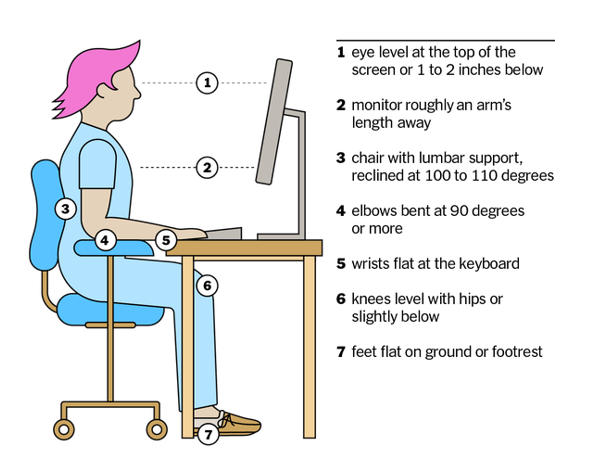Display Screen Equipment (DSE)
Although using a computer may not necessarily be a high-risk activity, if you are required to use any DSE such as accessing the PMR system on a regular basis for longer periods of time as opposed to just using it for short times there are some considerations, and you should ask your employer to complete a DSE user assessment form. This involves assessing how physically comfortable you are using the equipment.
The laws governing DSE and a 'DSE user assessment form' can be found in the Health and Safety Executive HSE (GB) website.
A poor set up of a workstation can lead to posture problems, wrist, neck or shoulder pain or headaches due to eyesight problems. If a problem is identified, adjustments will need to be made to either the computer or workstation, such as changing the height or distance of the monitor.
An example workstation set up:
- Arrange the desk and screen to avoid glare or bright reflections
- Check the screen height of display equipment and ensure that the angle is adjusted to allow a comfortable head position
- Ensure there is space in front of the keyboard to rest your hands and arms.
- Ensure enough room on the work top for the mouse and so the wrists are not bent (up, down, sideways)
- Allow space for a postural change, no clutter on the floor or under the counter.
- Keep shoulders relaxed
- Arms bent at elbows to allow comfortable keying position
- Forearms approximately horizontal
Support Available
Your employer should also protect workers from the health risks of working with display screen equipment (DSE), such as PCs, laptops, tablets and smartphones.
The Health and Safety (Display Screen Equipment) Regulations apply to workers who use DSE daily, for continuous periods of an hour or more. We describe these workers as 'DSE users'. The regulations don't apply to workers who use DSE infrequently or only use it for a short time.
How to protect workers' health
Within the law employers must:
- complete a DSE workstation assessment
- reduce risks, including making sure workers take regular breaks from their DSE
- provide an eye test for elligible staff
- provide training and information for workers
The law applies if users are, for example:
- at a fixed workstation
- mobile workers
- home workers
- hot-desking (workers should carry out a basic risk assessment if they change desks regularly)
There is also various equipment that could be provided to assist with a quality workstation set up for example:
- A desk at the proper height for yourself and your keyboard
- A comfortable chair that supports your spine
- An external ergonomic keyboard
- A mouse that fits your hand
- Quality room lighting
- Products that could help reduce distractions and stress e.g., noise cancelling ear-phones, angled speakers, plants, pictures etc


